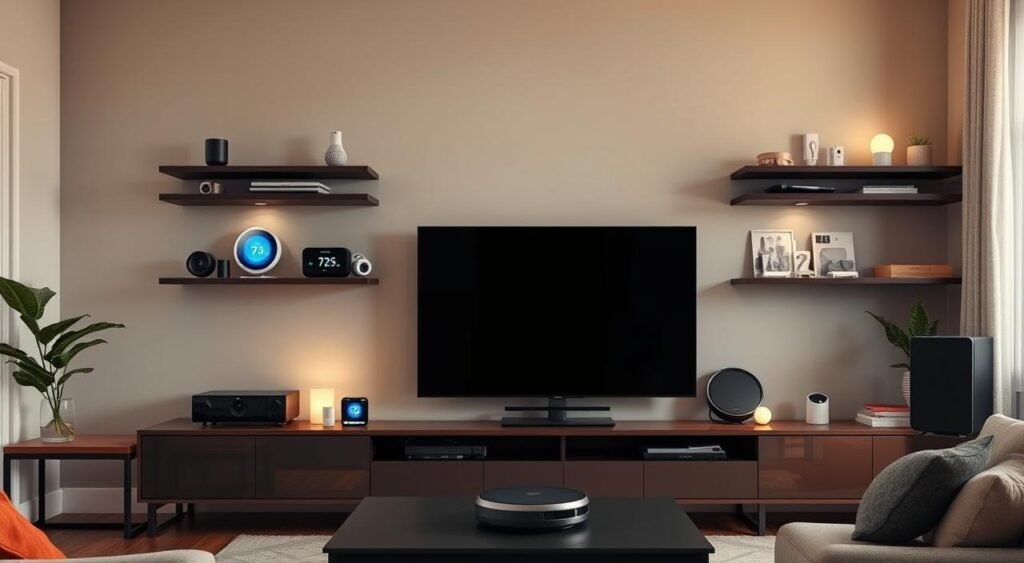Imagine a home that adjusts to your needs before you even ask. With over 300 million smart homes globally, and 60.4 million in the U.S., the smart home era has arrived. The list of the best smart home devices is ever-growing. It includes security systems like the TP-Link Tapo C120 and Arlo Video Doorbell, and sleek innovations like the Feather River Doors Smart Glass.
Your thermostat could learn your habits, your door unlock with a fingerprint, and your living room change with voice commands. This isn’t a future dream—it’s here today. Let me guide you through how these devices blend style and function, making your home smarter, safer, and more personal than ever.
Your front door could unlock with a fingerprint using the Ultraloq Bolt, while the Arlo Video Doorbell alerts you to deliveries. Smart thermostats from Nest and Honeywell save you money by learning your temperature preferences. Even simple tasks like switching a window from transparent to opaque with Feather River’s voice command become part of your daily routine. These aren’t just gadgets—they’re solutions that turn convenience into a lifestyle.
Whether you’re upgrading security with ADT Command’s professional monitoring or choosing SimpliSafe’s DIY setup, there’s a smart home path for every budget and style. My goal is to help you navigate the smart home devices list without feeling overwhelmed. I aim to highlight options that merge cutting-edge tech with real-world practicality. Ready to discover how these innovations can simplify your life? Let’s dive in!
Key Takeaways
- Smart home devices list includes security cameras like the weather-resistant TP-Link Tapo C120 and the two-way communication Arlo Video Doorbell.
- Over 60 million U.S. homes already use smart tech, proving their everyday value.
- Devices like the Feather River Smart Glass let you control privacy instantly with voice commands or apps.
- Top brands offer flexible choices—from professional systems like ADT Command to DIY-friendly picks like SimpliSafe.
- Smart thermostats from Nest and Honeywell cut energy costs while keeping your home comfortable.
Understanding Smart Home Technology and Its Benefits
Ever wonder how smart home tech can make your life easier? Let’s explore how the latest smart home technology transforms everyday routines into seamless experiences. From adjusting your thermostat with a tap to getting alerts when a package arrives—this tech is all about making your space smarter and more responsive.
Imagine this: your lights dimming as you relax on the couch, or your coffee brewing before you wake up. That’s the magic of smart home automation products! Let’s dive into how these systems work and why they’re a must-have for modern living.
How Smart Homes Are Revolutionizing Modern Living
Picture this scenario—you’re miles from home but can secure your doors with a swipe. Smart home automation products let you control lights, locks, and even irrigation systems remotely. They’re like having a personal assistant for your living space! For instance, energy-efficient smart thermostats can slash heating bills by learning your habits—no more wasting energy on empty rooms.
Key Advantages of Smart Home Integration
- Real-time security updates with motion sensors and live feeds
- Remote control of devices via smartphone apps
- AI-driven routines that adapt to your schedule
- Energy savings that add up to serious cost cuts
Take modern home designs today—they’re blending style with tech. Voice commands via Alexa or Google Assistant make managing your home as simple as speaking aloud. Even small steps, like using smart plugs to cut standby power waste, add up to big savings!
The Evolution of Home Automation Technologies
Remember when home automation meant just turning on lights remotely? Now, systems use machine learning to predict your needs. The latest smart home technology now includes solar panel integration and self-optimizing climate controls. Innovations like self-monitoring irrigation systems mean your garden stays lush without constant checking.
These advancements aren’t just about gadgets—they’re about living smarter. Ready to see how these tools can simplify your life? Let’s keep exploring!
Smart Home Devices List: Essential Products for Every Home
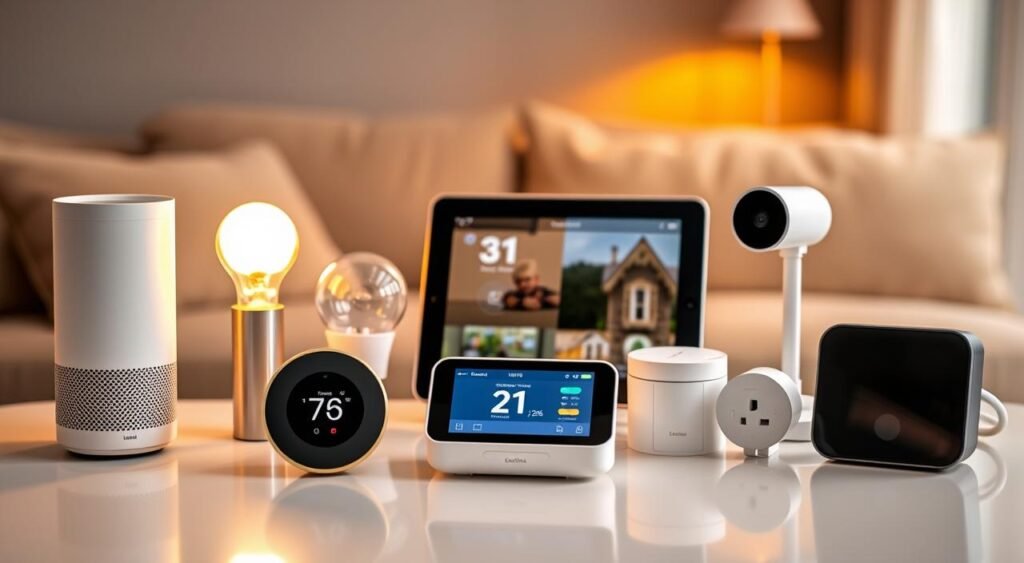
Ready to make your home smarter without overspending? Let’s explore the essential smart home appliances and affordable smart home devices every starter needs. I’ve tested dozens of options—here’s what works best for real-life routines.
Entry-Level Products
Start with these budget-friendly picks that solve everyday problems:
- Smart plugs (Kasa Smart Plug Mini) – control lamps or coffee makers remotely (under $20)
- Amazon Echo Dot (4th Gen) – voice commands for music, routines, and device control ($50)
- Eufy RoboVac G30 – cleans floors autonomously with Wi-Fi mapping ($180)
Must-Have Devices for Smart Home Beginners
These affordable smart home devices add instant value:
| Device | Key Feature | Price |
|---|---|---|
| Ecobee Smart Thermostat | Automates heating/cooling to cut energy costs | $150+ |
| Google Nest Hub | Screen-based control with privacy shutter | $100 |
| TP-Link Kasa Outdoor Camera | Weatherproof security with night vision | $100 |
Building Your Smart Ecosystem Step by Step
Begin with a central hub. I suggest starting with a voice assistant like the Amazon Echo Show 8 (included in my top picks above). Pair it with smart plugs and lights—these form the backbone of any connected home. For security, add a camera like the Arlo Pro 5S ($200) for 2K video clarity. Always check app compatibility to avoid fragmentation. Ready to upgrade? Swap your old thermostat for the $80 Amazon Smart Thermostat—it’s a game-changer for energy bills!
Smart Speakers and Voice Assistants
Imagine your home’s voice as your personal assistant—ready to play music, answer questions, or control lights with just your voice. Smart speakers like the Amazon Echo, Google Nest, and Sonos Era 100 are at the heart of the top smart home gadgets category. They’re more than speakers—they’re hubs for your entire smart ecosystem.
- Amazon Echo (4th Gen): Alexa’s strength shines with support for over 140,000 smart home devices comparison options. Its compact design and bold bass make it perfect for small spaces.
- Google Nest Audio: Crisp sound and Google’s search prowess let you ask anything—from recipes to traffic updates. Pair two for stereo sound!
- Sonos Era 100: Audiophiles love its room-tuning tech and Dolby Atmos support. It’s a standout in multiroom setups.
Choosing your main assistant matters. Apple HomePod users get seamless iPhone integration and top privacy features, while Google Assistant wins for natural conversation. Need music flexibility? The JBL Authentics 200 works with Alexa and Google Assistant. Pair this with the Google Pixel Tablet for multiuser control and security.
Confused about compatibility? Alexa’s vast device library makes it great for mixing brands. Apple’s ecosystem is tight but smaller. Test models like the Amazon Echo Dot or Google Nest Mini for budget setups before scaling up. Your voice deserves a helper that fits your lifestyle—so pick based on sound quality, voice assistant features, and the gadgets you already love.
Intelligent Lighting Systems and Solutions
Lighting innovations in the smart home devices list are both creative and practical. Imagine transforming your space with colors, brightness levels, and even syncing lights to movies or music! These systems simplify life without breaking the bank. 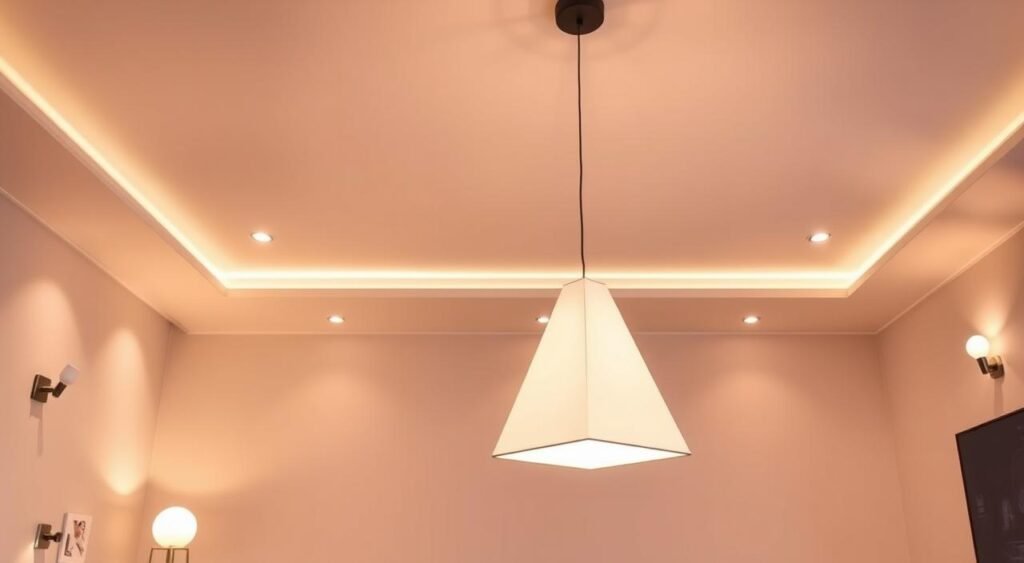
Smart Bulbs vs. Smart Switches
When deciding between bulbs or switches, smart home device reviews often favor Philips Hue bulbs. They offer vibrant color ranges (2700K to 6500K) and app control. On the other hand, Lutron Caseta switches work with existing bulbs, ideal for renters or those avoiding bulb swaps. Here’s a comparison:
| Option | Philips Hue Bulbs | Lutron Caseta Switches |
|---|---|---|
| Installation | Plug-and-play | Requires electrical work |
| Cost | $20–$50 per bulb | $100–$200 per switch |
| Flexibility | Color changes, dimming | Works with existing fixtures |
Ambient Lighting and Scene Creation
“My favorite feature? Setting a ‘Sunrise Simulation’ to wake up gently with light!” – Sarah, Philips Hue user
Create custom scenes like “Movie Night” with dimmed living room lights or “Relax” modes with warm tones. Nanoleaf Shapes panels take it further—syncing to music or games via voice commands. Pair them with Ring Pathlight Solar for outdoor pathways that light up with motion or sunset.
Energy-Efficient Lighting Options
Save 30% on energy bills with smart scheduling! Wiz Tunable White bulbs adjust brightness based on daylight, while Philips Hue Floodlights cut waste with motion sensors. Smart home device reviews praise Govee bulbs for their low-cost efficiency—$15 each but with 16 million colors!
Pro tip: Use timers to simulate occupancy when away, blending security and savings. Need help? I recommend starting with a starter kit—most systems let you expand gradually!
Advanced Home Security Devices
Imagine a security system as intuitive as your smartphone yet powerful enough to safeguard your home. Top smart home gadgets such as advanced security cameras, smart locks, and integrated systems are now essential for modern homeowners. These smart home automation products ensure your space is protected without a hefty price tag.
Cameras like the TP-Link Tapo C120 and Eufy S220 boast 4K resolution and AI to differentiate between a neighbor’s cat and an intruder. Combine these with Arlo doorbells that enable remote door answering or Ultraloq locks that eliminate the need for keys. Many systems also integrate with voice assistants, making your security a seamless part of your lifestyle.
| Brand | Key Features | SecureScore | Starting Price |
|---|---|---|---|
| ADT | 9.8/10, integrates with Google Nest | $349 | |
| SimpliSafe | 9.2/10, DIY-friendly, voice control | $250 | |
| Vivint | 9.1/10, AI cameras, 7-inch touch panel | $600 | |
| Cove | Easiest setup, Alexa/Google Home compat | $125 |
For complete peace of mind, systems like ADT or SimpliSafe combine cameras, sensors, and alarms into one app. Their SecureScore™ ratings (9.1–9.8/10) highlight their effectiveness without the high cost of traditional security. Even budget options like Ring Alarm ($125) offer DIY installation and compatibility with smart locks.
Integrate these tools with smart lights or thermostats from earlier sections to transform your home into a high-tech fortress. Prices range from $125 to $600, catering to every budget. Ready to enhance your home’s security and style? Begin with a camera or doorbell and expand as needed. Your safety is worth the investment, without the complexity.
Smart Thermostats and Climate Control

Let’s dive into climate control—the best smart home devices for energy and cost savings. Smart thermostats like Ecobee, Nest, and Amazon models adjust to your lifestyle, reducing heating and cooling costs by 10-15% each year. Picture this: sipping coffee while your system fine-tunes the temperature settings for you. Need evidence? Studies confirm these devices can cut utility bills significantly without compromising comfort.
“Smart thermostats save up to $200 yearly by optimizing energy use.”
Ready to compare? Here’s what to look for:
- Ecobee Smart Thermostat Premium: Includes remote sensors for even temperatures—ideal for open layouts.
- Nest Learning Thermostat: Utilizes AI, geofencing, and a free remote sensor to track room occupancy.
- Amazon Smart Thermostat: Offers budget-friendly Alexa integration but lacks multi-sensor setups.
Pair these smart home devices comparison winners with smart blinds or vents for complete climate control. For instance, Ecobee’s sensors work with your fan to circulate air more efficiently—bye-bye, sticky corners! Honeywell’s T9 model also integrates with HomeKit for Apple enthusiasts. Plus, voice commands allow you to adjust settings from anywhere.
Feeling overwhelmed by setup? Begin with a Nest or Sensi model, then add sensors as needed. Your wallet and the environment will appreciate it!
Kitchen Innovations and Smart Appliances
Transform your kitchen into a hub of efficiency with essential smart home appliances designed to simplify meal prep and enhance creativity. Imagine a fridge that texts you when you’re out of milk or a coffee maker that starts brewing before your alarm goes off. Let’s dive into the latest smart home technology reshaping how we cook!
- Smart Fridges: Models like Samsung’s Family Hub offer touchscreen displays for grocery lists, recipe suggestions, and internal cameras to check contents remotely.
- Cooking Assistants: The xBloom Studio adjusts brew settings to your taste, while the Anova Precision Cooker turns your crockpot into a sous vide master with app controls.
- Hands-Free Gadgets: The Dreo ChefMaker Combi Fryer handles frying, steaming, and sous vide—all controlled via Alexa or Google Assistant.
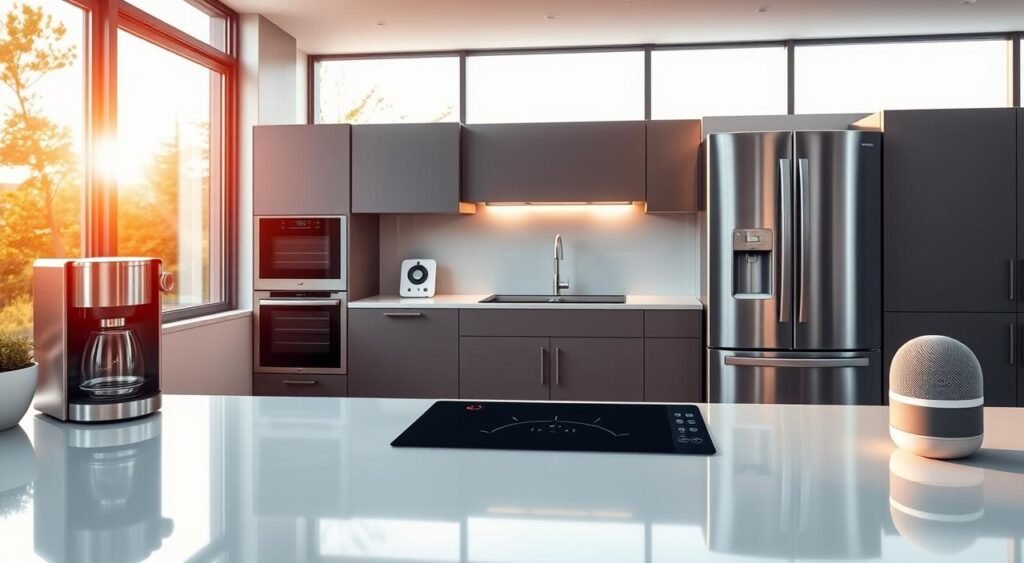
These tools aren’t just gadgets—they’re time savers. Pair your smart oven with voice commands to preheat while your fridge auto-orders groceries. Even small appliances like the Meater+ Smart Thermometer monitor meat temps remotely, ensuring perfectly cooked meals every time.
Want a garden in your kitchen? The AeroGarden Bounty Elite uses LED lights and app alerts to grow herbs year-round. And for those who love coffee, the Hamilton Beach Smart Coffee Maker lets you brew via phone—perfect for early risers!
These innovations aren’t just trends—they’re practical upgrades. Whether you’re a busy parent or a foodie, smart kitchen tech adapts to your lifestyle. Ready to upgrade? Start with one device and watch your kitchen evolve into a space that works for you!
Entertainment and Media Smart Devices
Ready to transform your living space into a cinematic wonderland? Explore the smart home devices list that combines style with cutting-edge technology. Imagine dimming lights with a wrist flick as a movie begins or calling up your favorite playlist with a voice command. This is entertainment reimagined.
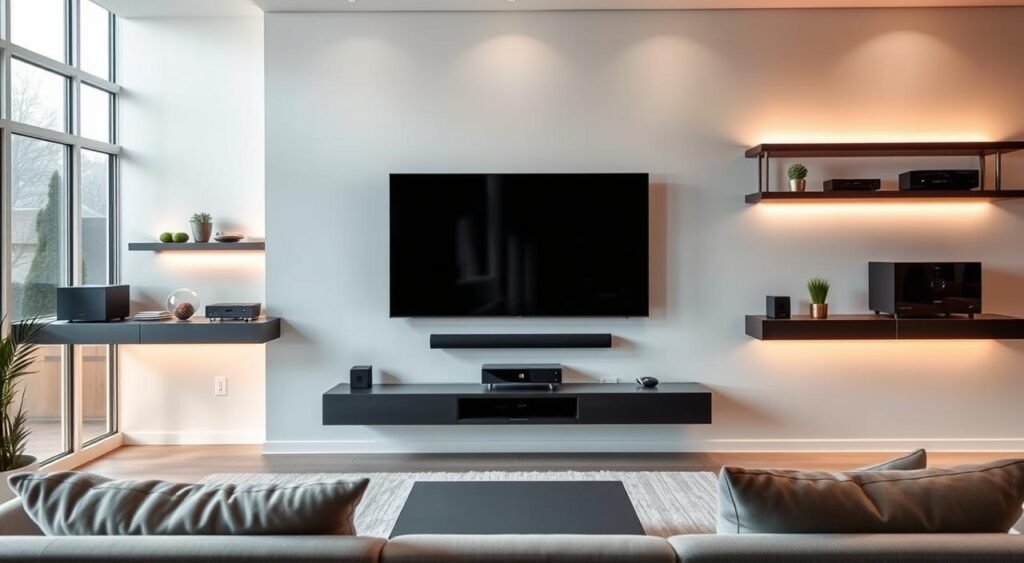
Streaming Devices and Smart TVs
Samsung, LG, and Sony’s 2023 models, like the Sony X95L OLED TV, offer 4K HDR and built-in voice assistants. For those with existing TVs, the Roku Ultra or Apple TV 4K add smart smarts without a full overhaul. The Amazon Fire TV Stick 4K supports Matter Casting for seamless app-to-screen syncing.
| Device | Key Features | Why It Shines |
|---|---|---|
| Sony X95J TV | Google Assistant, 4K HDR, voice search | Perfect for the smart home devices list—combines design and control. |
| Sonos One SL | Multi-room sync, Alexa/Google Assistant | A top smart home gadget for filling rooms with sound. |
| Keecker Pro | 360° sound, 48-hour battery, projector on wheels | Brings theaters to any wall in your smart home gadgets lineup. |
Multi-Room Audio Solutions
Sonos’ Arc Gen 2 delivers theater-quality sound, while Apple’s HomePod Mini pairs with iPhones for instant room-filling music. The Nuage Audio M1 lets you adjust bass via app—ideal for parties or cozy nights. Pair these with Philips Hue White and Color Ambiance lights to set the mood with a tap.
Creating the Ultimate Smart Home Theater
Begin with a central system like the LG C3 OLED TV and add Sioneer V500 soundbars for immersive audio. Incorporate Lift-Bit modular seating for a design-forward setup. Use the Simple Control app to link all devices—so pressing play dims lights, lowers shades, and queues up your playlist in one step.
Undecided? Google Chromecast with Google TV connects to existing screens, while Nintendo Switch games project onto walls via Keecker. Each piece on this smart home devices list works together. So, you can host movie nights where the tech fades into the background, leaving only the magic of seamless entertainment.
Smart Home Hubs and Integration Platforms
At the heart of every connected home lies a smart home hub—a central brain that ties your smart home automation products into one cohesive system. Whether you’re a tech novice or a DIY enthusiast, choosing the right hub ensures all your best smart home devices play nicely together.
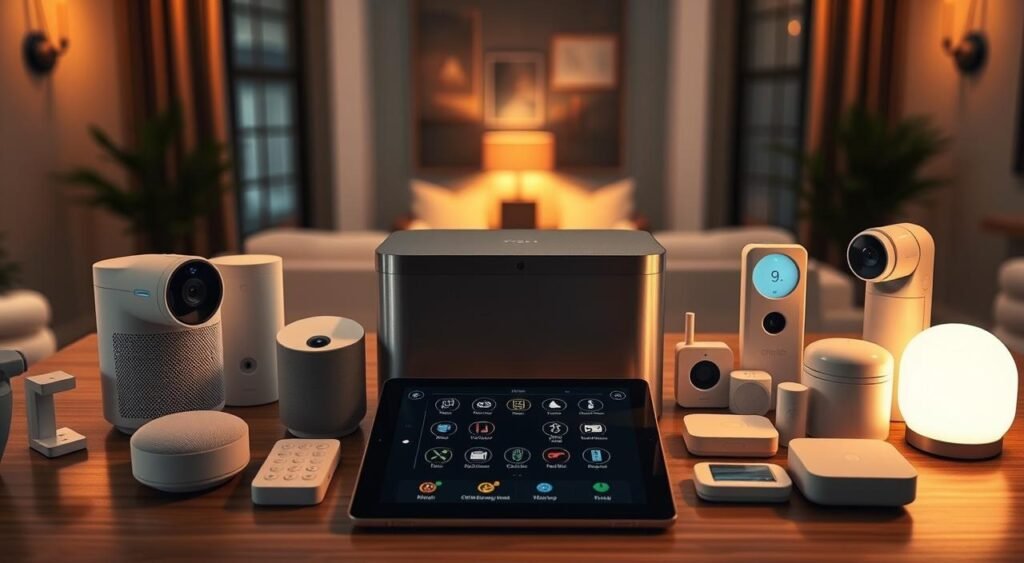
“Matter is revolutionizing compatibility between devices, letting you mix voice assistants without sacrificing control.”
Let’s break down top options to simplify your search:
- Apple HomePod 2: Combines high-fidelity sound with HomeKit integration, letting you manage lights, climate, and security via Siri.
- Amazon Echo (4th Gen): Supports Matter and Thread, plus advanced sensors for detecting smoke or glass breakage.
- Google Nest Hub Max: Offers a touchscreen interface to control cameras, thermostats, and locks—all from one screen.
When picking your hub, start with your priorities. Need energy-saving insights? Pair your hub with smart energy monitors for real-time usage tracking. Prefer offline functionality? Opt for hubs like Hubitat Elevation, which works even without Wi-Fi.
Ask yourself: Do you want voice commands via Alexa or Apple’s Home app? Check which protocols matter most—Zigbee, Z-Wave, or Matter compatibility. For example, Samsung’s SmartThings Station supports Zigbee and Thread, making it ideal for outdoor sensors. Apple TV 4K doubles as a HomeKit hub, perfect for streamlining an Apple-centric home.
Remember: Your hub isn’t just hardware—it’s the foundation for automation magic. Start small, then expand. Let your system grow with you, and soon you’ll have a space that truly feels like home.
Budget-Friendly Smart Home Devices That Deliver Value
Who says luxury tech has to cost a fortune? Let me share affordable smart home devices that add convenience without draining your wallet. Start small—smart plugs from brands like WiZ or iDevices Switch cost under $15 yet let you control lamps or heaters from anywhere. These essential smart home appliances are perfect for beginners.
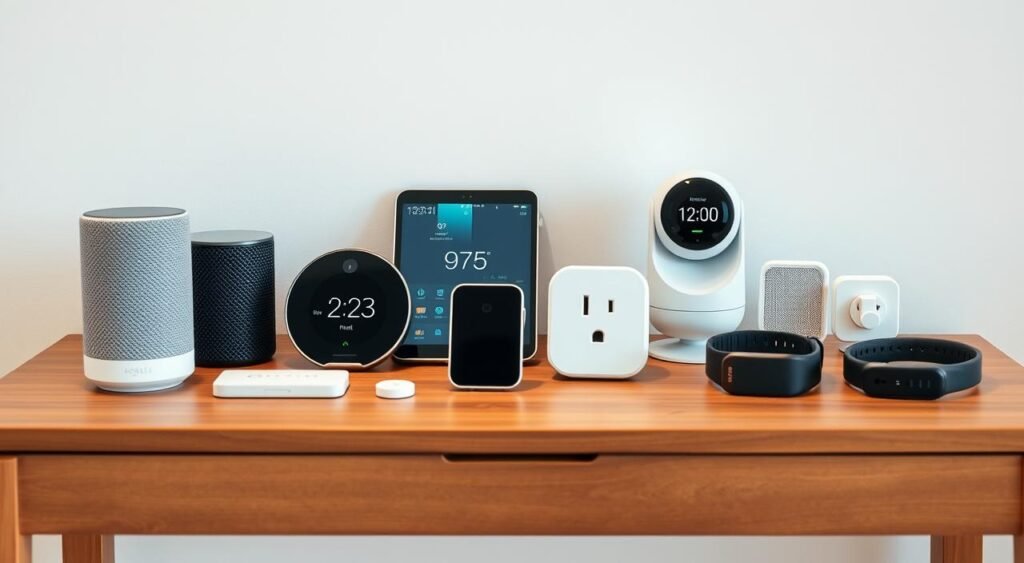
“Smart locks and sensors cut burglary risks—60% of thieves avoid homes with alarms.”
Here’s my top picks for under $50:
- Govee Wi-Fi LED Bulb: Shift colors via app—$15 vs. $50+ premium bulbs
- Drayton Wiser: Smart thermostat slashes heating bills by 8% annually—saves over $100 yearly
- YI Dome Camera: 1080p HD security for under $40—monitors your home day or night
Look for multi-use items like the Tile Mate tracker ($25)—find keys and control smart lights. Need entertainment? The Amazon Fire TV Stick streams 4K shows for just $40. Prioritize devices that solve real needs: A WiZ Smart Plug for the coffee maker, or a Hidrate Spark water bottle that reminds you to hydrate.
Start small. Mix-and-match affordable smart home devices to build your system over time. Every $20 smart bulb or $10 plug brings you closer to a fully automated home—without emptying your savings. Let me know what essential smart home appliances you’re adding first—I’m curious to hear!
Setting Up Your Smart Home: Tips for Seamless Integration
Planning your smart home setup begins with a solid foundation. Smart home device reviews reveal that Wi-Fi strength is a major issue, affecting 40% of users. We’ll explore how to sidestep common problems.
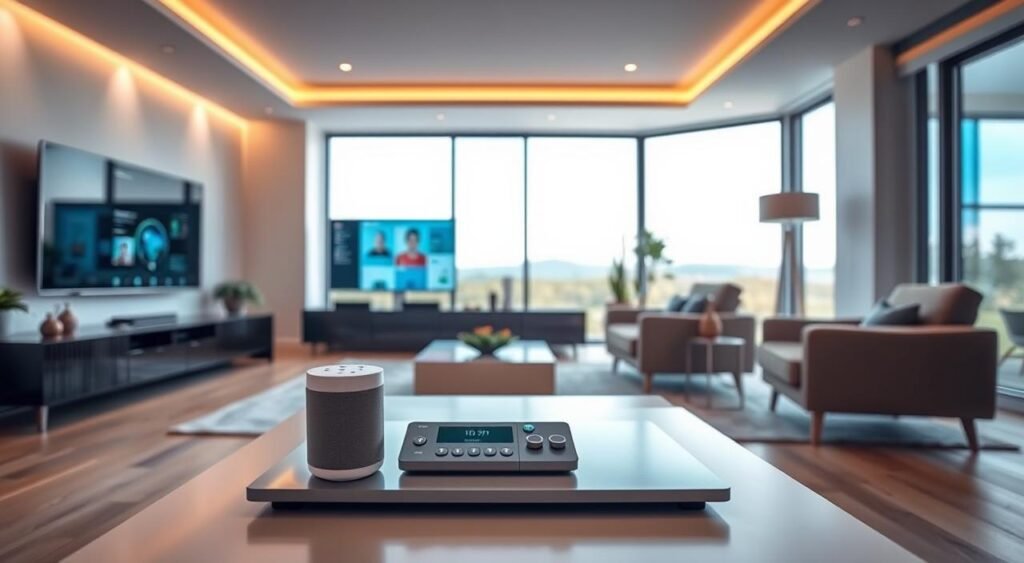
- For homes over 2,000 sq ft, invest in a mesh Wi-Fi system like Google Nest WiFi or eero.
- Place devices away from microwaves, cordless phones, and other Wi-Fi disruptors.
- Test signal strength in every room using free apps like Wi-Fi Analyzer.
Smart Home Ecosystem Comparison
| Feature | Google Home | Amazon Alexa | Apple HomeKit |
|---|---|---|---|
| Compatibility | Works with most brands | Best for third-party devices | iOS-only integration |
| Security | Standard encryption | Multi-layered security | End-to end encryption |
| Cost | Affordable entry points | Low-cost devices available | Higher upfront costs |
When selecting a system, refer to smart home devices comparison guides to align with your preferences. Always prioritize security: enable two-factor authentication and update firmware monthly. If a device freezes, try these steps:
- Restart the device and router first.
- Check manufacturer forums for known issues.
- Refer to the user manual’s troubleshooting section.
Begin with one device per week to avoid network overload. The best smart home device reviews focus on how products integrate, not just their individual performance. By following these guidelines, you’ll establish a robust system that evolves with your needs!
Future Trends in Smart Home Technology
Imagine your smart home not just following commands, but learning, anticipating, and adapting. The latest smart home technology is evolving from simple gadgets to sophisticated ecosystems. Let’s explore what’s on the horizon:
- Matter Standard Unlocks Compatibility: Apple, Amazon, and Google are joining forces with Matter. This move will end the era of ecosystem silos. Soon, all your smart home automation products will integrate seamlessly.
- AI-Powered Predictive Living: AI systems will soon adjust your home’s settings based on your habits. Imagine fridges that track expiration dates and suggest recipes for you.
- Health & Sustainability Focus: Smart mattresses will monitor your sleep, while air quality sensors improve your home’s environment. Devices like Nest Thermostats and smart power strips will also cut down on utility bills.
| Trend | Impact |
|---|---|
| Gesture Controls | Wave to dim lights or adjust shades without apps. |
| Biometric Security | Facial recognition and voiceprint authentication replace codes. |
| Robotic Assistants | Roomba’s latest models now handle mopping and even vacuuming pet hair autonomously. |

AI will soon tailor routines to your preferences. Picture your coffee maker brewing coffee as your alarm clock goes off. Brands like Philips are introducing solar-integrated lighting, merging sustainability with style. The aim is to create a home that feels like a trusted ally, not just a space.
Ready to dive into these innovations? Begin with a smart plug or sensor today. The future of smart homes is here, and it’s more accessible than ever.
Conclusion: Transforming Your Living Space with Smart Technology
Your journey to a smarter home begins with understanding the smart home devices list that aligns with your priorities. Whether it’s simplifying routines with voice commands or boosting safety with smart security systems, the right choices make everyday tasks seamless. Start by reviewing the smart home devices comparison to find solutions for your unique needs—like energy-saving thermostats from Nest or Philips Hue lights that adapt to your schedule.
Don’t get overwhelmed by the options. Begin with a voice assistant like Amazon Alexa or Google Nest, which can control lights and music. Smart locks from Schlage or Arlo cameras keep you secure. Expand gradually as you discover how devices like AI-powered sprinkler systems or pet-interactive cameras enhance your lifestyle. Remember, the best setups grow with you—pairing practicality with innovation.
Smart tech isn’t just about gadgets—it’s about reclaiming time and comfort. Imagine showers that conserve water, thermostats that cut bills, or security systems that alert you instantly. These tools aren’t futuristic fantasies; they’re here to simplify life. Use this guide to pinpoint which devices match your habits. Prioritize the areas that cause daily frustrations—like forgetting to lock doors or adjusting lights manually—and let smart home solutions tackle them automatically.
As you explore, keep an eye on emerging trends like self-learning AI systems that anticipate your routines. Brands like Ecobee and Lutron are already pushing boundaries, but the focus should always stay on your comfort. Start with the smart home devices list outlined here, then build outward. Your home can be a sanctuary of convenience, safety, and style—without breaking the bank. The future of living is here, and it’s tailored just for you.
FAQ
What are some essential smart home devices I should consider starting with?
Beginners should start with a voice assistant, such as Amazon Echo or Google Home. Smart plugs are also key, turning regular appliances into smart ones. Lastly, smart lighting options can greatly enhance your home’s ambiance.
How do smart thermostats save energy?
Smart thermostats save energy through geofencing and learning algorithms. They understand your preferences and adjust based on weather forecasts. This can lead to a 10-15% reduction in energy bills.
Can I integrate smart home devices from different brands?
Yes, many smart home devices, including those that follow the Matter standard, can work together. This makes your ecosystem more cohesive and functional.
Are there affordable smart home devices that offer great value?
Definitely! Options like TP-Link Kasa smart plugs and Wyze smart bulbs are affordable. They provide essential features without breaking the bank, making them perfect for starting your smart home journey.
What should I prioritize when setting up my smart home?
Ensure strong Wi-Fi coverage in your home. Choose devices that solve specific problems or enhance your routines. Gradually integrating devices will make the process smoother.
How do I secure my smart home devices?
Use strong, unique passwords for each device. Enable two-factor authentication and regularly update firmware. These steps are vital for protecting your smart home from vulnerabilities.
What are the benefits of using smart lighting systems?
Smart lighting systems can transform your home’s atmosphere. They save energy by using schedules and motion sensors. Plus, you can control them via voice commands or smartphone apps, adding versatility.
What new trends in smart home technology should I be aware of?
The integration of artificial intelligence in smart devices is a significant trend. It enables systems to anticipate your needs based on patterns. Advanced sensors for environmental awareness are also becoming more prevalent.
How can smart home devices improve my daily routine?
Smart home devices automate daily tasks, like turning on lights or adjusting temperatures. They save time and enhance comfort. This allows you to focus on what truly matters in your life.
